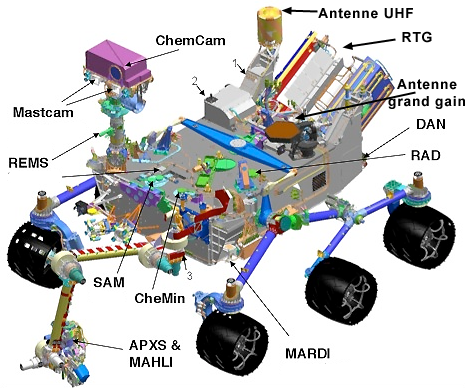The Mast Cameras (Mastcam) will be mounted on a bar beneath the Chemcam instrument high upon MSL’s Remote Sensing Mast. The cameras will be approximately two meters above the ground. Each camera is capable of acquiring natural color images and visible/near-infrared multispectral views (to help decipher mineralogy). Images from these cameras can also be used to construct stereo representations of the MSL site and can acquire video sequences of high definition quality.
The basic characteristics of the Mastcam system are:
Mastcam shares common elements in terms of design, parts, and labor, with the other MSSS cameras for MSL, the MAHLI and MARDI.
Mastcam consists of four hardware elements: two camera heads and their matching two Digital Electronics Assemblies (DEA) that control each camera. The cameras are mounted on a bar on the MSL Remote Sensing Mast. Four DEAs, one for each of the cameras provided by MSSS (the two Mastcams, the MARDI, and the MAHLI) are housed together within a single box inside the temperature-controlled interior of the rover.
Both Mastcam camera heads have a mechanical focus and autofocus capability. The cameras can focus between 2.1 meters (the nearest view to the surface from the cameras’ position on the Remote Sensing Mast) and infinity.
One Mastcam camera head has a 100 mm focal length, f/10 lens. This provides the capability to obtain images with a scale of 7.4 centimeters per pixel at 1 km distance, and about 150 microns per pixel at 2 meters distance. The camera’s square field of view covers 5.1° over 1200 by 1200 pixels on the instrument’s 1600 by 1200 CCD.
The other Mastcam camera head has a 34 mm focal length, f/8 lens. The camera’s 15° square field of view covers 1200 by 1200 pixels on a 1600 by 1200 CCD detector. The camera can obtain 450 microns per pixel images at 2 meters distance and 22 centimeters per pixel at 1 kilometer distance.
Each Mastcam uses a Bayer Pattern Filter CCD to obtain natural color pictures of a quality just like that of consumer digital cameras. This provides nearly true color views—that is, similar to what the human eye would see on Mars. Using the Bayer approach eliminates the usual need for planetary spacecraft cameras to take 3 separate images (and thus a greater data volume), one through a red filter, one through a green filter, and one through a blue filter, to provide a color view of the scene (some Mars cameras, such as the Mars Global Surveyor MOC wide angle system, actually used 2 filters, a red and a blue, and synthesized the green from a known relationship between red and blue for Mars).
Bayer Pattern Filter CCD array.
Bayer Pattern Filter CCD array. Each detector, which translates to being a pixel in a digital image, is covered by a red, green, or blue filter arranged in the pattern shown here. This is a common approach to color digital imaging, used in commercial cameras.
Each Mastcam camera head also has a filter wheel, so that images taken by looking through filters covering different, narrow visible and near-infrared wavelengths can be obtained. Filters for the 34 mm Mastcam are (in nanometers): 440, 525, 550, 675, 750, 865, 1034, and 440(neutral density). Filters for the 100 mm Mastcam are (in nanometers): 440, 525, 550, 800, 905, 935, 1035, and 880(neutral density). The neutral density filters are for viewing the Sun. Each filter wheel also includes a visually clear (actually infrared rejection coated) filter for nominal RGB (red, green, blue) imaging using the Bayer Pattern CCD.
Each Mastcam is capable of acquiring 720p high definition video (1280 by 720 pixels) at a rate of about 10 frames per second.
Color image mosaics of the full 360° martian landscape around the MSL rover can be acquired quickly—within an hour. With a large internal data storage capability of 8 Gbytes, these data can be stored indefinitely (until commanded by the camera operations team to be deleted). Thumbnail images of 200 by 150 pixels are returned to Earth for all images, and then the science team can select which full frames in a given mosaic are to be returned to Earth for scientific analysis.
The Mastcam system is capable of being used to acquire stereo pair (3-d) images, although this is not a major emphasis of the investigation because of the differing focal lengths of the two camera lenses.
The figure below shows the Mastcam fields of view as compared with the Mars Exploration Rover Pancam. Pancam acquires 1024 by 1024 pixel images covering 16° x 16°. Mastcam frames are 1200 by 1200 pixels, with the 34 mm lens covering 15° x 15°, and the 100 mm lens covering 5.1° x 5.1°. Thus the 34 mm Mastcam is roughly 1.25X higher spatial resolution than the MER Pancam, and the 100 mm Mastcam is 3.67X higher spatial resolution.
.










